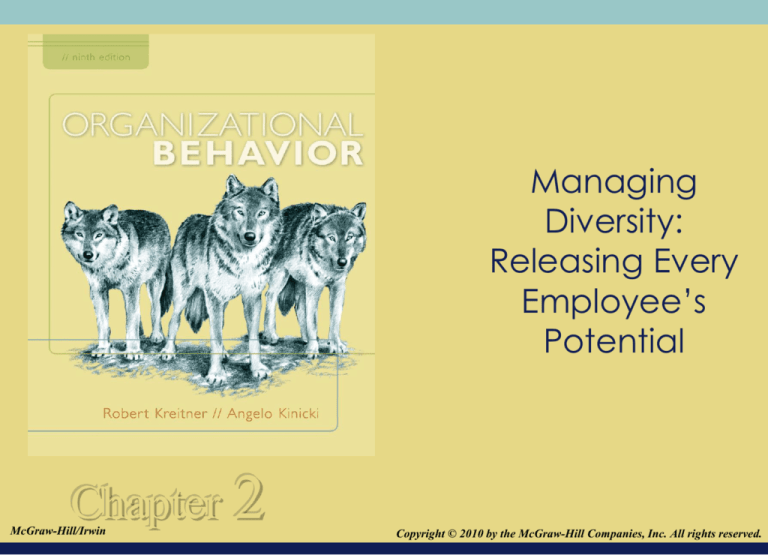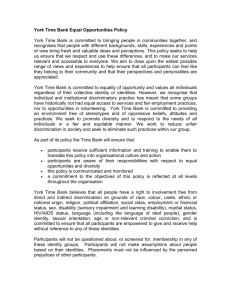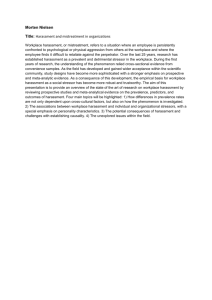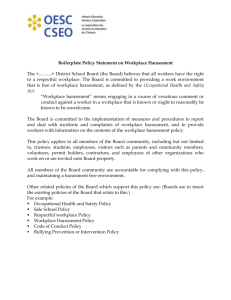
Managing
Diversity:
Releasing Every
Employee’s
Potential
Chapter 2
McGraw-Hill/Irwin
Copyright © 2010 by the McGraw-Hill Companies, Inc. All rights reserved.
© 2008The McGraw-Hill Companies, Inc. All rights reserved.
Ch. 2 Learning Objectives
1. Define diversity and review the four layers of
diversity.
2. Explain the difference between affirmative action
and managing diversity.
3. Explain why Alice Eagly and Linda Arlie believe
that a women’s career is best viewed as traveling
through a labyrinth.
4. Review the demographic trends pertaining to
racial groups, educational mismatches, and an
aging workforce.
2-2
Ch. 2 Learning Objectives (con’t)
5. Highlight the managerial implications of
increasing diversity in the workforce.
6. Describe the positive and negative effects of
diversity by using social categorization theory
and information/decision-making theory.
7. Identify the barriers and challenges to managing
diversity.
8. Discuss the organizational practices used to
effectively manage diversity as identified by R.
Roosevelt Thomas, Jr.
2-3
Understanding Diversity
Diversity: Host of individual differences that
make us similar and different from each other
Please stand up…..
If the statement made doesn’t pertain to you
have a seat!
If a statement does describe you, stand up
again!
2-4
The Four Layers of Diversity
Functional Level/
Classification
Geographic Location
Mgmt.
Status
Marital
Status
Parental
Status
Age
Income
Work
Content/
Field
Personal
Habits
Race
Personality
Appearance
Union
Affiliation
Sexual
Orientation
Ethnicity
Work
Experience
Work
Location
Physical
Ability
Recreational
Habits
Religion
Educational
Background
Division/
Dept./
Unit/
Group
Source: L Gardenswartz
and A Rowe, Diverse
Teams
at Work: Capitalizing on
the Power of Diversity
(New
York: McGraw-Hill,
1994), p. 33
Seniority
2-5
Test Your Knowledge
Sam is a 55 year-old, male Sales
Manager for XYZ corporation. He likes
to drive fast cars and is Native
American. Which layer of diversity has
not been mentioned about Sam?
A.Personality
B. Internal
C. External
D.Organizational
2-6
Affirmative Action
Goal: Prevent
discrimination
Never required to
hire unqualified
people
Your Opinion
Have affirmative action
programs been good
for society?
• A=Yes, B=No
Are affirmative action
programs still
necessary?
• A=Yes, B=No
2-7
Managing Diversity
Enables all people
to perform up to
their maximum
potential.
How can managing
diversity be a
competitive
advantage?
2-8
Increased Workforce Diversity - Women
Glass Ceiling
• Invisible barrier blocking women and
minorities from top management
positions
Women CEO’s (as of 2008):
• 12 of Fortune 500
• 24 of Fortune 1000
2-9
Navigating a Labyrinth
Women have made
great strides in
organizational power
and influence
Labyrinth – maze,
difficult to find one’s
way
Women’s careers have
similar twists, turns and
obstructions
2-10
Increased Workforce Diversity - Race
Racial minorities
are growing
• 2007 – 998 racebased charges
of
discrimination
to EEOC
2-11
Education and Personal Income
2-12
Does the US have the skills to
compete?
World’s population of college students
• 30% 30 years ago – now 14%
American students place in the middle to bottom of
the pack in comparison to international counterparts
in achievement in
• Math
• Science
• General literacy
2-13
Increased Workforce Diversity - Age
2-14
Generational Differences
2-15
Your Experience
For school group projects, it has been
easier to work with groups we could
choose rather than one’s the professor
chose.
• 1= Strongly Disagree
• 2 = Disagree
• 3 = Neutral
• 4 = Agree
• 5 = Strongly Agree
2-16
Managerial Implications - Gender
Provide developmental assignments to women
Facilitate the labyrinth-like path to career success
Women should:
• Be exceptionally competent & seek out mentors
• Build social capital
• Assist work/life balance by delegating housework
• Improve negotiating skills
• Take credit for accomplishments
• Create a partnership with spouse to be mutually
supportive
• Balance need to be assertive and communal
2-17
Managerial Implications – Race &
Education
Race
• Provide meaningful mentoring relationships to people of
color
Education-based
• Encourage students to become educated in technical
fields
• Provide remedial skills training
2-18
Managerial Implications – Age
Provide challenging work assignments that make a difference to
the firm
Give the employee considerable autonomy and latitude in
completing a task.
Provide equal access to training and learning opportunities when
it comes to new technology.
Provide frequent recognition for skills, experience, and wisdom
gained over the years.
Provide mentoring opportunities whereby older workers can
pass on accumulated knowledge to younger employees.
Ensure that older workers receive sensitive, high-quality
supervision
Design a work environment that is both stimulating and fun. 2-19
Pros and Cons of Diversity
Social categorization theory
• Similarity leads to liking and attraction
Information/Decision-Making Theory
• Diversity leads to better task-relevant
processes and decision-making
2-20
A Process Model of Diversity
2-21
Effects of Diverse Work
Environments
Gender and
racial
diversity in a
work group
fosters more
interpersonal
conflict
which leads
to
lower job
satisfaction,
higher
turnover,
and lower
productivity
2-22
Effects of Diverse Work
Environments
Demographic faultline
• Hypothetical dividing lines that may split a
group into subgroups based on one or more
attributes
Diverse groups had positive
outcomes when….
• members were open-minded, discussed and
shared information, and displayed
integrative behavior
2-23
Managing Diversity
What can
organizations do to
facilitate the POSITIVE
outcomes of diversity?
2-24
Challenges to Managing Diversity
What barriers exist
for organizations
trying to manage
diversity?
2-25
Thomas’s Generic Action Options
Responses to handling diversity issues:
Option 1: Include/Exclude
Option 2: Deny
Which ones are
Option 3: Assimilate
most effective for
Option 4: Suppress
managing
diversity?
Option 5: Isolate
Option 6: Tolerate
Option 7: Build Relationships
Option 8: Foster Mutual Adaptation
2-26
Managing
Diversity:
Releasing Every
Employee’s
Potential
Supplemental
Slides
Chapter 2
© 2008The McGraw-Hill Companies, Inc. All rights reserved.
Women Gain (Hidden) Ground in
Boardroom
Board membership data conceals
real gains in progress
Lead Directors
2001 – 1.8%
2007 – 8.1%
9%
80% of Fortune 500
boards have at least Percentage of women
on crucial committees
one woman
(e.g., Audit,
2007 - 76 had three
Compensation,
women – up 34% from corporate governance
2001
Source: Dalton, D. Women Gain (Hidden) Ground in the Boardroom, Harvard Business Review,
January, 2009.
2-28
Women Gain Ground in Boardroom
(con’t)
What factors might contribute to this trend?
What can organization’s do to improve representation
on boards and improve the influence of diverse
perspectives?
What are some group dynamics that marginalize the
impact of certain individuals?
2-29
The Mid-Life Crisis: An
Opportunity?
People are living longer, requiring the need to think hard about
one’s career in later years
Mid-life crises often start with concern over physical limitations
but can grow into a deeper exploration of one’s desire for
personally fulfilling work
Organizations can assist by
• helping people plan their second careers
• funding continuing education for personal development; not
just improved job performance
Organizations benefit by retaining talented, knowledgeable, and
engaged employees who can help mentor younger generations
Source: Strenger, C. & Ruttenberg, A. The Existential Necessity of Midlife Change, Harvard
2-30
Business Review, February 2008.
The Mid-Life Crisis: An
Opportunity? (con’t)
Have you or anyone you know gone through a mid-life career
transition?
What was that experience like? How did their organization help
or hinder their progress towards their second career?
How might you measure the impact or benefit of programs to
improve retention and engagement of older employees?
Source: Strenger, C. & Ruttenberg, A. The Existential Necessity of Midlife Change, Harvard
Business Review, February 2008.
2-31
EEOC: Train Managers on
Harassment
Court cases almost 13 years ago, provided employers
an opportunity to defend themselves against
harassment charges
BUT still many managers don’t know what to do if
accused of harassment
Organizations need to:
• Train managers on harassment laws
• Have policies in place to handle harassment claims
• Conduct proper investigations
Source: Deschenaux, J. EEOC: Train Managers on Harassment, HR Magazine, May
2008
2-32
EEOC: Train Managers on
Harassment (con’t)
What types of policies or procedures exist at places
you’ve worked?
What is your experience with them?
What are the obstacles in communicating this type of
information in your organization?
Source: Deschenaux, J. EEOC: Train Managers on Harassment, HR Magazine, May
2008
2-33
Illegal Immigration
22,186,393
No. of illegal
immigrants in US
4,717,100
No. of children of
illegal's in public
schools
Impact on
Business?
11,079,244
Skilled jobs taken by
illegal immigrants
394,637
No. of illegal
immigrants
incarcerated
Source:http://immigrationcounters.com/; extracted 6/1/2009
2-34
Impact of Restrictions on
Immigration?
Bill Gates to Congress
• Ensure highly trained immigrants have ability to work in
US
• Will hinder the US’s ability to compete globally if we limit
our ability to innovate
• Need to improve federal funding for science and
mathematics education
• Argues that at Microsoft every highly trained immigrant
created other jobs at Microsoft
Source: Boles, C. Last Call? Gates Pushes Globalism in Remarks, Wall Street Journal, p. B3,
3/13/2008
2-35
Generations in the Workplace
We now have 4 generations represented
in the workforce
•Matures 1901-1943
•Baby Boomers 1943-1960
•Gen X 1960-1980
•Gen Y 1980-2000
2-36
The Millenials are Coming
“Generation Y, at nearly 80 million strong,
outnumbers the 78.5 million baby boomers
and 48 million Generation X-ers, so it’s to an
employer’s benefit, to learn how to deal with
them.” (Gurchiek, 2008)
Morley Safer reports on how the Millenials, also
known as Generation Y, are impacting the workforce
today
Watch the 60 Minutes video, The Millenials are
Coming”
Source: Gurchiek, K. (2008) Survey: Generational Conflicts Aggravate Talent Shortage, SHRM HR News.
2-37
Multi-Generational Workforce
Company’s who maximize crossgenerational communication improve
knowledge transfer yielding
• Better competitive position
• Increased learning and development of
employees
Source: Kovary, G. (2008). How to Get, Keep, and Grow all Four Generations. 60th Annual SHRM Conference, Chicago,
IL.
2-38
Benefits of Hiring Older Workers
Need for
motivation
is less
An end to
workplace
politics
Punctuality
is a nonissue
Less
turnover
Hiring
Older
Workers
Source: Work is the New Retirement, Training, March/April 2009, vol. 46.
Good
customer
service
skills
Good role
models
2-39
Managing Diverse Schedules
% of companies
allowing flexible
schedules at
least 20% of
time
Small
80%
Medium
60%
Source: Best Small and Medium Companies to Work for in America, HR Magazine, July 2008
2-40
Managing Diverse Schedules (con’t)
What types of flexible work programs
have your experienced at work?
What were their pros and cons?
What challenges do organizations face
when attempting to accommodate
varying schedules?
What are the benefits?
2-41
Leaders in Diversity: Deloitte
Business case for retaining and
promoting women:
• Growing segment of labor market
• Women have lots of choices
• Clients expect composition of
consultants to mirror their own
Assessed cultural barriers for women
Source: Women Leaders; Symposium, 22nd Annual Conference of the Society of Industrial and
Organizational Psychologists; April, 2007, New York, NY
2-42
Leaders in Diversity: Deloitte
Actions taken to retain and promote women:
Allow choice with regard to:
• Pace of career progression
• Workload
• Location and schedule of work
Allow for up to 5 year leave of absence but
opportunities to remain connected (company-wide
2006)
•
•
•
•
Maintain professional certifications (e.g., CPA)
Assigned a mentor and career coach
Attend Deloitte functions
Work as independent contractor
Source: Women Leaders; Symposium, 22nd Annual Conference of the Society of Industrial and Organizational Psychologists;
April, 2007, New York, NY
2-43
Leaders in Diversity: Deloitte
Results:
• 21% women partner / principal / directors Deloitte leads Big 4
• 46% women employees
• Consistently recognized on Working Mother’s
‘100 Best Companies for Working Mother’s’
honor roll
• Over 400 Professional development,
networking and mentoring activities
Source: Women Leaders; Symposium, 22nd Annual Conference of the Society of Industrial and Organizational Psychologists;
April, 2007, New York, NY
2-44
Video Cases
Starbucks
Pike Place Fish Market
2-45
Management in the Movies –
The Inside Man – “Bugged”
In this scene, Det. Frazier is talking with Sergeant
Collins (Victor Colicchio) about a previous experience.
What apparent biases does Sergeant Collins have?
How does Det. Frazier deal with Sergeant Collins
apparent stereotypes?
How should an employee deal with another
employee’s bias?
2-46
Diversity Challenges
Bailey’s Health Center, Falls Church
• Repeatedly, patients would not return for their followup visits or call and cancel
• Most were immigrants from Central America
• Why?
Hospital in Michigan
• Large % of Vietnamese women were dehydrated after
giving birth?
• Why?
Source: Reshaping Bedside Manner in a Diverse World, S. Levine, Feb. 6, 2006,
Washington Post
2-47
Strategic Value of Diversity
Gallup survey conducted in late 2005 found:
15% of US workers experienced discrimination in the
workplace over the past year
Positive perceptions of the company’s diversity efforts
was related to:
• Satisfaction with the company
• Likelihood of staying with the company
• Probability of recommending the company to others
Source: Employee Discrimination in the Workplace, The Gallup Poll, 11/10/05
2-48
Office Closet Empties Out
Poll conducted in April 2006 found:
74% of gay and lesbian employees say they are
completely out at work up from 47% in 2003
15% say they have told selected co-workers but not
their bosses
Of Fortune 500, 246 offer domestic-partnership
benefits today up from 28 in 1996
Source: BusinessWeek, May 1, 2006; Jessi Hempel, The Office Closet Empties Out
2-49
Leaders in Diversity
Pepsi’s CEO & direct reports
are each assigned different
employee group (e.g., GLT,
Asian, women of color)
Responsible for:
• Understanding the issues
these employees face
• Facilitating their growth
and development
Hold themselves
accountable
Source: Diversity Finds Its Place, R. Rodriquez, August 2006, HR Magazine
2-50
Leveling the Field
Coaching: providing perspective and
assistance on career development
• Typically not performed by manager
• Scope extends current job
38.7% said minorities receive coaching
at the same rate as their representation
in the workforce
11.7 %said minorities receive coaching
at lower rate than the typical worker
Source: HR Magazine, July 2006, Minority Employees Skipped for Coaching, Kathy Gurchiek
2-51
Land Executives, Not Lawsuits
35.5% of all charges filed with EEOC
cite race as basis of discrimination
(2005)
EEOC is focused on reducing “systemic
discrimination”
• Occurs when an organization’s
policies, practice, and/or culture fail to
address discriminatory actions
Source: HR Magazine, October 2006, Land Executives, Not Lawsuits, Jonathan A. Segal, Esq.
2-52
Younger Women at the Top
Women who make it
into executive ranks get
there faster than men
75% of Fortune 1,000
women executive
officers are 50 or
younger
Percentage of male and
female Fortune 1,000
executive officers in
each age category
35
30
25
20
15
10
5
0
28-40
41-45
46-50
Females
Males
2-53
Diversity Training
What is diversity training?
Why do companies invest in it?
What types of diversity training are
most effective?
• Awareness or Skills/Behavioral?
2-54
Denny’s: A Turnaround
Background
1993 – Class action case against Denny’s for
racial discrimination
Ended in a settlement that included:
• Mandatory diversity training for all employees
• Random testing of restaurants for treatment of
customers
2-55
Denny’s: A Turnaround
How did Denny’s respond?
Changed leadership (CEO), added Chief
Diversity Officer
Implemented skills-based diversity
training
Held managers accountable for diverse
staff and fair treatment of customers
2-56
Denny’s: A Turnaround
What was the outcome?
Significant increase in minority-owned
franchises
Management team is 31% minority, up from
21% in 1993
Board is 33% minority
Denny’s placed first for two years on
Fortune’s best place to work for minorities
2-57
Diversity and Competitive Advantage
How does your organization leverage diversity
for a competitive advantage?
My organization doesn't actively
leverage diversity
Increasing innovation through diverse
employees
30%
34%
39%
Meeting needs of diverse customers
Leadership development for all
employees
0%
40%
10%
20%
30%
40%
% Respondents out of 310
1-58
2-58
Business Case for Workplace Diversity
Direct Link: Expanding customer base with
diverse workforce
• DuPont – a drug they produce was low in the
Hispanic market
• Hispanic manager noticed the label was only
in English; they had it translated and sales
improved
• Significant increase in minority-owned
franchises
2-59
Business Case for Workplace Diversity
Indirect Link: Retaining Employees
• Nortel lost revenue due to turnover
• Turnover cost - $55,000 average cost per
employee
• “Attracting and keeping talent – a key aspect
of workplace diversity – has a significant
impact on the bottom line.”
Taken from Workplace Diversity: Leveraging the Power of Difference for Competitive Advantage
2005 SHRM Research Quarterly
2-60
Conclusion
Questions for discussion
2-61









